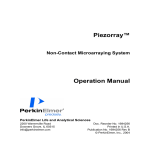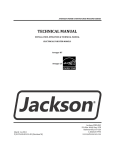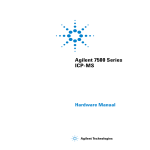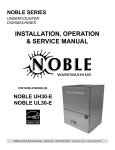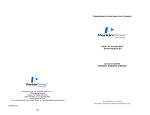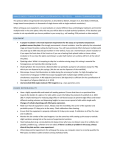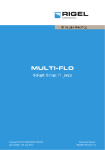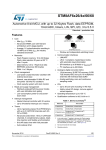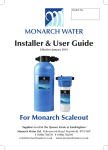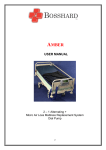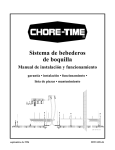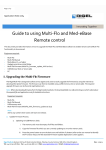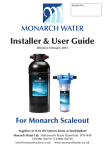Download Analysis of Nuclear Stained Cells - Using the Cytation™3 - Bio-Tek
Transcript
A p p l i c a t i o n N o t e Cell Imaging Analysis of Nuclear Stained Cells Using the Cytation™3 Cell Imaging Multi-Mode Microplate Reader with DAPI-Stained Cells Paul Held Ph. D. and Peter Banks, Ph. D., Applications Department, BioTek Instruments, Inc., Winooski, VT The imaging and analysis of fluorescently stained cells has traditionally been accomplished using manual microscopic methods with low numbers of samples, while the analysis of higher sample numbers requires the use of very expensive dedicated microscopes. Here we demonstrate digital fluorescence microscopy using the Cytation™3, a novel imaging multi-mode microplate reader capable of both whole well intensity measurements using a PMT detection and digital inverted microscopy with a CCD detection. Gen5™ Data Analysis Software provides cell segmentation and counting in microplate wells. Onecolor staining of cells is performed in 96-well microplates and imaged using 4x and 20x microscope objectives. Introduction Key Words: DAPI Imaging Nuclei Cell Count Immunofluorescence Staining BioTek Instruments, Inc. P.O. Box 998, Highland Park, Winooski, Vermont 05404-0998 USA Phone: 888-451-5171 Outside the USA: 802-655-4740 Email: [email protected] www.biotek.com Copyright © 2013 Microscopy is a vast array of technologies used for the visualization of samples and objects that cannot be seen with the unaided eye. The earliest microscopes were developed about 400 years ago by the pioneers Hooke and van Leeuwenhoek. Hooke famously coined the term “cell’ to identify microscopic structures when he was describing cork; van Leeuwenhoek, commonly known as "the Father of Microbiology" was the first to observe and describe single-celled microorganisms, such as bacteria, sperm and blood cells. A simple optical microscope uses only one lens for magnification, and is the original design of light microscope used by these pioneers. Today compound microscopes are typically used which have multiple lenses (i.e. an eyepiece and objective lens). In the life sciences, particularly cell biology, fluorescence microscopy in conjunction with an arsenal of fluorescent probes, is widely used due to its ability to localize and quantify specific molecules in cells. Vendors such as Nikon, Olympus and Zeiss all have broad ranges of fluorescence microscope offerings differing in resolving power. Digital microscopes are now available which use light emitting diodes, microscope objectives and a CCD camera to image cells, displaying the resulting image directly on a computer screen without the need for eyepieces. The ease of use of these devices, the portability of the digitized images and the ability to accommodate multiple sample vessels, such as microscope slides, tissue culture flasks and microplates, are leading features that has driven adoption. These digital microscopes have been designed to allow imaging from microplates since this is an experimental vessel of choice for many laboratories as it offers the ability to perform multiple experiments in a convenient, inexpensive format that minimizes reagent usage and experiment cost. It is used in conjunction with microplate readers across myriad applications in the life sciences such as nucleic acid and total protein quantification, ELISAs, enzyme kinetics, and a multitude of cell-based assays that quantify cellular processes in either live cell or endpoint formats. In this application note, we describe a novel cell imaging multi-mode microplate reader that provides the ability to perform quantitative assays typical of a microplate reader but also digital fluorescence and brightfield microscopy using either microplates or microscope slides. We illustrate the instrument’s ability to capture total fluorescence and image DAPI-stained cells using clear-bottomed microplates. The instrument’s ability to count cells using image analysis parameters to define objects (nuclei) using the reader’s cellular analysis software is described. Application Note Cell Imaging Materials and Methods Methods NIH3T3-GFP (Cell Biolabs Inc) cells were grown in Advanced DMEM (cat # 12491) from Life Technologies supplemented with 10% FBS, 2 mM glutamine. Blacksided, clear bottom 96-well (cat# 3603) microplates were from Corning. TopSeal-A (cat # 6050195) adhesive plate sealers were from PerkinElmer. DAPI dihydrochloride stain (cat# D1306), and DPBS (cat# 14190), were obtained from Life Technologies. Paraformadehyde (cat# P6148) powder was obtained from Sigma-Aldrich, while Triton X-100 (cat # X198-05) was from Baker. Cell Culture Cell cultures were maintained at 37°C, 5% CO2 in a humidified incubator. Cultures were routinely trypsinized (0.05% Trypsin-EDTA) at 80% confluency. For experiments, cells were plated at various cell densities using the peripump dispenser of the MultiFlo Dispenser (BioTek Instruments). 2 Figure 1. Fixation and Staining Procedure Workflow. Fixation and Cell Staining Cytation™3 Cells were washed once with 200 µL of PBS (NaCl 137 mM, KCl 2.7 mM, Na2HPO4 10 mM, KH2PO4 7.4 mM) prior to fixation using the EL406 washer manifold. After which 100 µL of 4% paraformaldehyde (PFA) solution was added using the EL406™ syringe pump dispenser manifold. PFA solution was made daily by dissolving 4 g of powder into 100 mL of DPBS warmed to 60 °C. Cells were fixed for 10 minutes at room temperature followed by 2 washes of 200 µL using DPBS. Following the fixation process, cells were stained for 10 minutes using 50 µL of PBS containing 0.1% Triton X-100 with 30 µM DAPI. Cells were stained 10 minutes at room temperature followed by 2 washes with 200 µL of DPBS. After aspiration 100 µL of PBS was added to all wells and the plates sealed using TopSeal-A adhesive plate sealer (Perkin Elmer). Prepared plates were kept at room temperature and protected from light prior to imaging. Briefly, Cytation3 is a multi-mode microplate reader that incorporates up to three separate optical paths. In top reading mode, Cytation3 operates as other BioTek microplate readers possessing Hybrid Technology™: double quadruple grating monochromators provide flexibility in wavelength selection for absorbance and fluorescence measurements; filter cubes housing excitation and emission filters separated by a dichroic mirror provide sensitive analysis in fluorescence intensity, time-resolved fluorescence, FRET, TR-FRET and fluorescence polarization detection modes. Top reading luminescence detection can be performed with the filter cubes either with or without emission filters. All top reading uses PMTs for detection. Bottom reading is reserved for CCD-based digital inverted widefield microscopy either in bright field or fluorescence modes. Three separate LEDs and filter cubes allow for red, green and blue fluorescence imaging using 2x, 4x, 10x or 20x microscope objectives (2x and 10x are available as options). Gen5 software, common to other BioTek microplate readers has been augmented to provide autofocusing of cells in microplates, capturing of images with both automatic or user defined parameters (LED intensity, CCD gain, integration time) and cellular analysis algorithms that allow for cell segmentation and cell counting. Greater details on Cytation hardware and software is available in the Cytation3 user manual. Application Note Results Analysis Parameters for Cellular Image Analysis Cellular analysis of images, such as cell counting, requires the coordinated optimization of multiple analysis parameters. Because cells and cellular objects, such as nuclei, vary in size, morphology, and extent of fluorescent staining, a number of parameters such as intensity threshold, minimum and maximum object size, and whether or not to split touching objects need to be optimized in order to obtain a correct cell counts. Threshold refers to the background subtracted intensity that Gen5 uses to determine separation between objects. Should the threshold intensity be set too low, then multiple objects may be considered a single object. The Cellular Analysis feature of Gen5 allows the user to select either default settings or user-defined ones (Figure 2). Cell Imaging Changing the Threshold intensity setting and Min. and Max. object size induces changes in the number, shape, and size of the counted objects observed. With higher Threshold values the counted areas become smaller in size and more regular in appearance. As observed in Figure 3, when the Threshold value is set to 1000, the counted regions are large, have an irregular shape and obviously do not conform to the blue objects (nuclei). Many counted cells are immediately adjacent to one another. When the same image is analyzed with a Threshold of 10,000, the counted regions are significantly smaller, discrete, rounded and conform to the blue objects. These empirical observations are corroborated by the statistical data presented in Table 1. Figure 2. Cellular Analysis tab of Gen5: Analysis parameters are located above the image of DAPI-stained nuclei. In this analysis, the stained nuclei are the objects which have been analyzed with all analysis parameters set to default. Counted nuclei (and thus cells) have a gold perimeter associated with them, drawn by Gen5. Note nuclei at the edge of the image are not counted (no gold perimeter) as the Include edge objects analysis parameter is “unchecked.” The manipulation of these analysis parameters results in significant changes in the discrete objects identified. Using the criteria defined by these analysis parameters, Gen5 defines contiguous regions or areas that are outlined by the designated Threshold intensity value. These regions are counted as “cells”. 3 Cell count decreases from 92 to 74 with a threshold change from 1,000 to 10,000 respectively. In addition the measured size, area and perimeter decrease with an increasing threshold setting. The object circularity, which is a measure of roundness increases with increasing threshold, which is more indicative of the shape of nuclei. Application Note Cell Imaging Figure 3. Effect of Threshold value on cell count analysis. Cellular analysis of 20x images at various Threshold values. Arrows indicate a common cluster of three stained nuclei which becomes better analyzed as a cell nucleus with increasing Threshold intensity levels. DAPI stained cells were imaged using the Blue filter cube of the Cytation™3 and cellular analysis performed with default settings except for Threshold. Threshold value is indicated for each analysis is indicated. Analysis 1000 Threshold Values 5000 7500 10000 Cell Count Object Size Object Area Object Perimeter Object Circularity Object Mean 92 23.5 494 98.1 0.432 12974 78 18.5 280 66.1 0.501 29314 74 17.7 249 60.4 0.529 34334 74 17.2 234 58.3 0.553 36964 Table 1. Cellular Analysis of Individual DAPI-stained nuclei at different Threshold values. The significance of these analysis parameters can be observed by following three cells identified by the arrows in Figure 3. With very low intensity Threshold values (e.g. 1,000) the cell nuclei are poorly defined as objects. With higher threshold value (e.g. 10,000) individual cell nuclei are denoted with little to no extra nuclear regions outlined. While it is quite easy to select the Threshold values empirically through trial and error, Gen5 provides a line profile tool that can assist in optimizing the Threshold intensity. By using the Zoom function one can examine the effect of several different parameter settings quickly and easily. 4 Threshold Analysis Optimization of the Threshold intensity analysis parameter has the greatest effect towards obtaining most accurate cell counting. The ability to differentiate adjacent objects with different Threshold values can be demonstrated using the line analysis tool in Gen5™ software. With a threshold setting of 5000 the image of DAPI-stained nuclei can only be distinguished into two cells (Figure 4A), despite obviously being three separate nuclei visually in the image. In addition the indicated gap between the two defined objects is skewed away from the indicated nadir of the trace. Application Note Cell Imaging The intensity profile of the line analysis also strongly suggests the presence of three discrete cell nuclei (Figure 4B). When the threshold is increased to 10,000 these three cell nuclei can be visually distinguished and the cells identified with the intensity profile. Note that the indicated gap between two of the cells is still skewed but to a lesser degree. When a threshold setting of 30,000 is selected in Figure 4C three cells are distinguished and the object gap of the line A. profile correctly defines each cell, but the outline of the objects is obviously internal to the visible image of the stained nuclei. The irregular shape of the object profiles along with the obvious intrusion of the gold perimeter into the blue image of the stained nuclei suggests that this Threshold value is too high. This is corroborated by the intensity profile, which indicates that significant signal is outside of the profile. B. I Figure 4. Use of the line tool to manually assess Threshold intensity setting for accurate cell counting. A portion of an image was analyzed using the line tool in Gen5 at three different Threshold intensity values. Data on the left (A) depicts the image of three nuclei along with the line trace being analyzed, while data to the right (B) corresponds to the intensity profile along the line trace. Scale bar indicates 10 µm. Object Size Definition In addition to the Threshold intensity value one needs to place upper and lower limits on the object size. Defining the approximate size of the intended objects to be analyzed elimiates unwanted debris, which is often found in cell based experiments. This debris can be fluorescent and needs to be culled from the data prior to analysis even though it meets the threshold criteria cut off. The easiest way to define object size is to use the zoom feature in conjuntion with the scale bar. 5 A visual comparison of the scale bar to a few different imaged objects will provide an approximate dimension. One must take care in selecting the size in order to not exclude true objects. As depicted in Figure 5, size does matter. In seperate analysis of the same image using an intensity threshold of 20,000 to define objects when a size criteria that defines objects as being between 5-100 µm three separate objects have been identified. However, by increasing the minimum size to 15 µm one of the identified objects has been excluded from the count. Application Note Cell Imaging Figure 5. Use of the scale bar to assess object size minima and maxima from imaged cellular objects. Scale bar indicates 10 µm. Splitting Touching Objects The Gen5™ Data Analysis Software can be enabled to employ a mathematical algorithm to separate touching objects. This feature is often used with cellular counting, particularly with cell densities that result in cells touching, or with embryonic or induced pluripotent stem cells, which typically grow as colonies. These situations require the enablement of the Split touching objects analysis parameter. Alternatively if the question is how many colonies are present one would disable the feature. The advantage of this feature for individual cell counting is depicted in Figure 6, where the parameter has been either enabled or disabled while keeping other analysis parameters constant. With Split touching objects disabled, only two cells being counted; if enabled, the correct cell count is performed. Figure 6. Effect of Split touching objects on cell counting. Scale bar indicates 10 µm. 6 Application Note Cell Imaging Cell Counting Once the optimal analysis parameters have been determined, cellular analysis of the entire plate can be performed. Images of DAPI stained NIH3T3 linear cell titrations show distinctly different numbers of nuclei that correspond to the number of cells seeded (Figure 7). Figure 7. Cell Titration of DAPI stained cells Imaged at 20x. NIH3T3 fibroblasts were fixed and stained with DAPI and then imaged in the Blue channel at 20x magnification. The number of cells seeded into each well is indicated. Cell seeding density was determined by a hemocytometer. Scale bar indicates 80 µm. When the same microplate is read from the top as a well intensity using excitation and emission wavelengths that correspond to the fluorescent dye DAPI, a linear relationship between cell number and fluorescent signal is observed (Figure 8C), as one would expect with a linear titration of DAPI-stained cells. When different cellular image analysis data is plotted, similar results are observed. The image mean is the average of the entire blue signal measured by the imager and essentially the equivalent of a standard fluorescence measurement albeit with a much smaller probe size. These data also demonstrate a linear relationship to cell number (Figure 8B). Likewise, the cellular analysis or cell count is also linear with respect to cell number (Figure 8A). Figure 8. Comparison of Different Quantitative Methodologies. The cell count and image signal mean from an image using the 20x objective was compared to the mean signal from a conventional top read fluorescence microplate read. Graphs depict (A) Object cell count data (B) Mean value for imaged data; or (C) Top-read fluorescence signal plotted against total number of cells seeded. Data points represent the mean of eight determinations. 7 Application Note Lower magnification images and/or higher cell densities can be analyzed in the same fashion. As Cell Imaging demonstrated in Figure 9, where a serial titration of cells were imaged using the 4x objective. Figure 9. Cell Titration of DAPI-stained cells Imaged at 4x. NIH3T3 fibroblasts were fixed and stained with DAPI and then imaged in the Blue channel at 4x magnification. The number of cells seeded into each well is indicated. Scale bar indicates 400 µm. These data can also be segmented and counted using the same object analysis parameters as defined for the 20x image analysis. Starting with significantly greater numbers of cells a serial dilution was both imaged and top-read fluorescence determined. As with the linear titration data using lower cell numbers, the cell count and mean blue signal graphs generated through the imager result in very similar shaped graphs as was observed from a conventional fluorescence measurement. With this broad range of cell numbers the strengths and weaknesses of both measurement modalities becomes apparent. At very high cell densities the imager becomes less effective. One can note that the counted cell number begins to level off at a seeding density of approximately 25,000 cells per well and is virtually flat from 50,000 to 100,000 cells per well (Figure 10A), whereas top-read fluorescence continues to increase. With low cell numbers (e.g. <200) cell counting is able to make significant determinations verses an empty well, while the top-read fluorescence measurement cannot. Figure 10. Comparison of Different Quantitative Methodologies. The cell count and image signal mean from a 2x2 array image using the 4x objective was compared to the mean total well signal from a top read fluorescence measurement . Graphs depict (A) Object cell count data (B) Mean value for imaged data; or (C) Top-read fluorescence signal plotted against total number of cells seeded. Data points represent the mean of eight determinations. 8 Application Note Cell Imaging Discussion These data demonstrate the need and utility of optimizing the object analysis parameters prior to counting objects (cell nuclei). While the parameters can be set individually, they actually work in concert with one another to best analyze the data in hand. When selecting the Threshold intensity, it is advisable to use the line analysis tool to get an estimate for the most appropriate level (25% of the peak background-subtracted intensity demonstrated along the line tool). Using too low a level will artificially count too many objects as cells; too high a threshold will exclude actual objects. Likewise selection of correct Min. and Max.object size serves to exclude fluorescent signal caused by cellular debris or foreign objects (dust) that may be present in the well. For example DNA from lysed cells might be present and result in an intense fluorescent signal, but be too small to actually constitute a true cell. With the correct Min. object size, this phenomenon would be eliminated from analysis. The Split touching objects parameter is by default enabled and will be used as such for most cellular analysis. Tissue samples and tissue cultured cells are very often touching to one another by being adjacent or on top of one another. Object cell counting is typically performed by counting nuclei, which can be in close proximity to one another in the vertical plane. The ability to discriminate touching yet distinctly different objects provides a more accurate count. Once the proper object analysis parameters have been set, accurate object analysis such as cell counting can be performed. The Cytation™3 Cell Imaging Multi-Mode Reader is distinctly unique in its ability to not only to generate CCD-based digital image data using microscope objectives, but to also be able to detect fluorescence in microplate wells using a PMT detector. These data presented demonstrate the signal to cell number relationship similarity between counted cell number and epifluorescence. This combination allows an investigator to use conventional fluorescence measurements, which are much faster to generate and require significantly less data storage capacity to identify wells of interest that can then be imaged. 9 AN041013_13, Rev. 04/10/13









